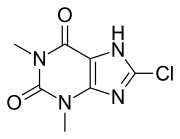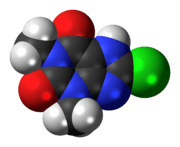8-Chlorotheophylline
 | |
 | |
| Clinical data | |
|---|---|
| Routes of administration | Oral |
| ATC code |
|
| Legal status | |
| Legal status |
|
| Identifiers | |
| |
| CAS Number |
|
| PubChem CID | |
| ChemSpider |
|
| UNII | |
| ChEBI | |
| ChEMBL | |
| ECHA InfoCard | 100.001.446 |
| Chemical and physical data | |
| Formula | C7H7ClN4O2 |
| Molar mass | 214.61 g/mol |
| 3D model (JSmol) | |
| |
| |
| | |
8-Chlorotheophylline, also known as 1,3-dimethyl-8-chloroxanthine, is a stimulant drug of the xanthine chemical class, with physiological effects similar to caffeine.[1] Its main use is in combination with diphenhydramine in the antiemetic dimenhydrinate. Diphenhydramine reduces nausea but causes drowsiness, and the stimulant properties of 8-Chlorotheophylline help ward off that side-effect.
References
- ↑ S H Snyder; J J Katims; Z Annau; R F Bruns & J W Daly (May 1, 1981). "Adenosine receptors and behavioral actions of methylxanthines". PNAS. 78: 3260–3264. doi:10.1073/pnas.78.5.3260.
| Receptor (ligands) |
| ||||||||||
|---|---|---|---|---|---|---|---|---|---|---|---|
| Transporter (blockers) |
| ||||||||||
| Enzyme (inhibitors) |
| ||||||||||
| Others | |||||||||||
See also: Receptor/signaling modulators | |||||||||||
This article is issued from
Wikipedia.
The text is licensed under Creative Commons - Attribution - Sharealike.
Additional terms may apply for the media files.